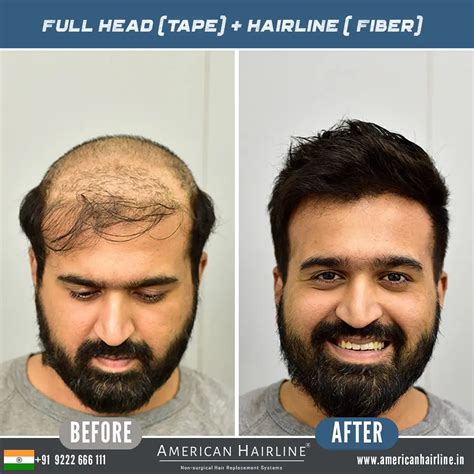Introduction
Hair loss is a common concern among men, affecting millions worldwide. While there are various factors contributing to hair loss, such as genetics, hormonal changes, and lifestyle choices, it can significantly impact an individual’s self-esteem and confidence. Hair replacement solutions have emerged as a popular and effective way for men to address hair loss and restore a fuller, more youthful appearance.

Statistics and Prevalence
- The American Hair Loss Association estimates that approximately 50% of American men experience some degree of hair loss by the age of 50.
- The International Society of Hair Restoration Surgery (ISHRS) reports that over 90% of hair loss in men is caused by androgenetic alopecia (male pattern baldness).
Types of Hair Replacement for Men
The market offers various hair replacement options tailored to individual needs and preferences. Here are the most common types:
1. Surgical Hair Restoration
- Follicular Unit Transplantation (FUT): In FUT, a strip of scalp with healthy hair follicles is removed from the back of the head and transplanted into the bald or thinning areas.
- Follicular Unit Extraction (FUE): FUE involves extracting individual hair follicles from the donor area and implanting them into the recipient site.
Benefits of Surgical Hair Restoration:
- Long-lasting results (typically permanent)
- Natural-looking hair growth
Drawbacks of Surgical Hair Restoration:
- Invasive procedure with potential scarring
- Higher cost than non-surgical options
2. Non-Surgical Hair Replacement
- Hairpieces and Wigs: Hairpieces and wigs are pre-made units made from synthetic or human hair that can be attached to the scalp.
- Non-Surgical Laser Therapy: This therapy uses low-level laser energy to stimulate hair growth and improve hair density.
- Medications and Supplements: Certain medications, such as finasteride and minoxidil, can slow down hair loss and promote hair growth.
Benefits of Non-Surgical Hair Replacement:
- Non-invasive and less expensive than surgical options
- More convenient and customizable
Drawbacks of Non-Surgical Hair Replacement:
- Temporary results (requires ongoing maintenance)
- May appear less natural than surgical options
3. Hybrid Hair Replacement
- Combining surgical and non-surgical methods, hybrid hair replacement involves using both techniques to achieve a fuller, more natural-looking результат.
Factors to Consider When Choosing Hair Replacement
- Extent of Hair Loss: The severity of hair loss will determine the most suitable hair replacement option.
- Age and Health: Surgical hair restoration may not be suitable for older individuals or those with certain health conditions.
- Budget: The cost of hair replacement can vary significantly depending on the type of procedure and materials used.
- Lifestyle and Activity Level: Non-surgical options may be more convenient for active individuals who need a less invasive solution.
- Personal Preferences: Ultimately, the choice of hair replacement method should reflect the individual’s personal style and lifestyle.
Consultation and Procedure
- Consultation: Before undergoing any hair replacement procedure, it is essential to consult with a qualified hair restoration specialist. This consultation involves a thorough assessment of the hair loss, medical history, and lifestyle factors.
- Procedure: Depending on the chosen hair replacement method, the procedure may take several hours to complete. It is crucial to follow the instructions and recommendations of the hair restoration specialist to ensure optimal results.
Aftercare and Maintenance
- Post-Procedure Care: Proper aftercare is vital to ensure successful hair replacement. Following the surgeon’s instructions, including wound care and medication, is essential.
- Ongoing Maintenance: Non-surgical hair replacement options require ongoing maintenance, such as regular styling and cleaning. Surgical hair restoration typically requires less maintenance but may require occasional follow-up appointments for monitoring and touch-ups.
Effectiveness and Success Rates
The effectiveness of hair replacement varies depending on the type of procedure, individual factors, and adherence to the aftercare instructions.
- Surgical hair restoration has a high success rate, typically resulting in permanent hair growth.
- Non-surgical hair replacement options provide temporary results and may require ongoing use to maintain desired outcomes.
Customer Testimonials
- “After years of struggling with hair loss, surgical hair restoration gave me back my confidence and a fuller head of hair.” – John, 45
- “The non-surgical laser therapy sessions have noticeably improved the density and thickness of my hair.” – Sarah, 32
- “I’m so happy with my hairpiece. It’s comfortable to wear, and it looks and feels like natural hair.” – Mark, 50
Conclusion
Hair replacement for men bietet a broad spectrum of solutions to address hair loss and restore a youthful appearance. By understanding the different options, factors to consider, and potential results, men can make informed decisions about the most suitable hair replacement method for their individual needs and goals. With advanced techniques and квалифицированные hair restoration specialists, men can regain their confidence and embrace a fuller, more natural-looking hair.
